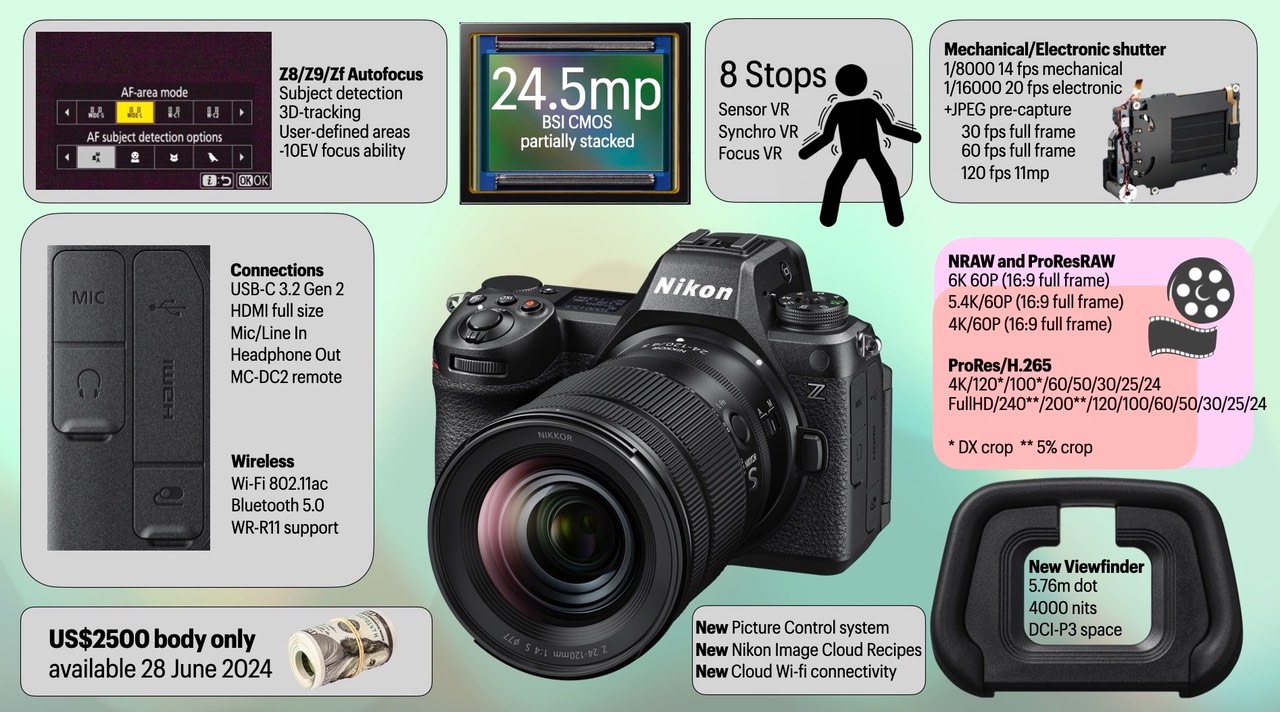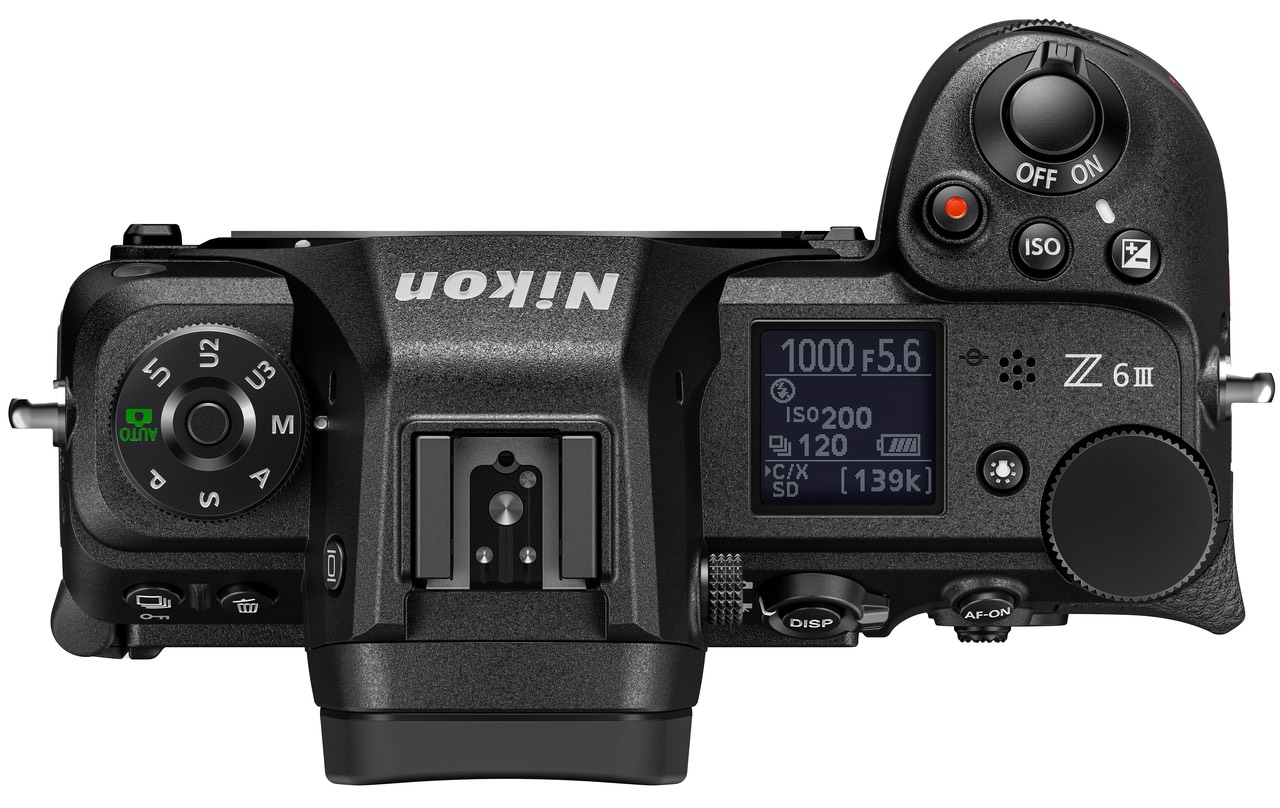
Today Nikon launched the third iteration of their mid-range Z6 model, bringing more Z9-goodness down the lineup. The Z8 was a smaller body near-replica of the Z9, and the Zf was a curious "shove the electronics into a retro body" offering. The Z6 III is much more like a Z8 in a Z6 body with a 24mp instead of 45mp image sensor.
This article will describe the new camera in detail and stick mostly to the basic features. If you're interested in a comparison to other models, see my "How Does it Compare" article also posted today. If you're interested in more of an analysis, see the "Worth the Wait?" article. If you're mostly interested in how the Z6 III fits into the Z System lineup, check out the "New State of the Z System" article.
There's lots to digest, so let's dig in. (Warning: this article and the Z6 III data page may update as I learn more and begin using the camera. Disclosure: I was given a full briefing on the new camera prior to launch, but not a copy to use and handle prior to the actual launch event.)
As everyone expected and Nikon hinted at, the Z9-goodness is spreading downward in the lineup and has reached the Z6 level (while skipping over the Z7 for the time being). At the heart of the new camera is the EXPEED7 processor first seen in the Z9, and that enables so many of the recent advances in features and performance in the Z System. To wit:
- Pre-release capture
- Pixel-shift shooting
- HEIF image format
- High efficiency raw formats
- Skin softening and Portrait impression balance
- New AF-area modes and Subject detection
- Synchro VR
- H.265 and ProRes video compression
- Raw video capture
- Viewfinder size
For most Z6 users, the autofocus, pre-release capture, and pixel-shift changes are probably the most welcome, particularly the first one. The Z6 and Z6 II both featured an autofocus system mostly derived from the Nikon 1, including the infamous Subject tracking option. The Z6 III now gets the Zf/Z8/Z9 focus options, which include user-defined areas and 3D-tracking. Moreover, the machine-taught subject detection system comes along, giving the Z6 III both the focus performance and control that its bigger brothers pioneered. Focus response is stated as -10EV normally (f/1.2 lens at ISO 100), and that's without invoking a low-light mode.
Yes, the image sensor is still 24mp. However for static subjects you can use pixel-shift to get pretty incredible 96mp files. Since many opted for a Z7 because of the "more pixels" for things like landscapes and city scenes, pixel-shift on the Z6 III (and Zf) sort of renders a Z7 III moot for the moment.
The Z6 III sports what Nikon is calling a partially-stacked image sensor, which is designed to provide ultrafast readout—3.5x the speed compared to the Z6 II—to the EXPEED7 brain, similar to the Z8 and Z9, as many had hoped. It appears that Nikon is using top and bottom sides of sensor electronics to achieve most of the speed boost via an extra set of stacked (only in those areas) electronics.
The image sensor is stabilized similarly to the Zf, which means 8-stops of reduction. Synchro VR and Sensor Focus VR are both supported.
Meanwhile, the speed improvements on the 24mp image sensor have allowed for some new video capabilities: There's a 6K 60P, as well as 5.4K 60P, 4K UHD 120P, and FullHD 240P max video choices (the latter two are cropped). N-RAW and ProResRAW, as well as H.265 compressions all make their way into the Z6 III, as well. Maximum video recording time is 2 hours, 5 minutes. I'm told that's a hard limit (probably due to file construction while recording), and Nikon claimed to me that they've actually run the camera to those limits without overheating. Anyone recording audio should also note that the amplifier has been changed in the Z6 III. It now supports both line and mic inputs, and produces 24-bit data (up from 16-bit).
Many were worried about body size creep when the original rumors started to appear about Z6 III prototypes. The body has definitely put on a few millimeters and ounces, but it's still much smaller (and lighter) than a Z8. That keeps the Z6 III in the small, all-around travel camera category, which is a largish portion of the Z6 user target. I get it, you want to know the actuals, so here they are: 5.5x4x3" (138.5x101.5x74mm) and 26.9 ounces (760g). So .2" wider and deeper, and 2 ounces (55g) heavier. However, the body lines are slightly different, and internally there's been some changes to help with keeping the image sensor cool. Meanwhile, Nikon is stating that dust- and weather-protection should be equal to that of the Z8, as the body construction and seals are similar.
In terms of controls on the body (buttons, dials, etc.) the Z6 III has the same basic controls as the earlier Z6 models, but it orients them in the Z8/Z9 positions. In other words, the playback button is now in the lower right back button cluster, not at the top left above the Rear LCD. The Protect/Fn3 button of the Z8 becomes the Release Mode/Protect button on the Z6 III.
Up top we have Mode Dial instead of a button, with the usual U# custom setting positions. Curiously, the light-the-top-LCD control has moved from the On/Off button to a separate one. Still, overall, Z5, Z6, Z6 II, Z7, and Z7 II users will find the body and its controls close enough to what they have and should be able to easily move over to the new body. On the other hand, fewer buttons than the Z8 body mean less customization possibilities.

Two big adjustments to the body are the articulating Rear LCD and a higher resolution (5.76m dot) viewfinder. The EVF, in particular, is interesting in that it is brighter than any previous ones (4000 nits max; the Z8 and Z9 max out at 3000 nits), plus the viewfinder now supports the DCI-P3 color space. I'm told that the brightness of the EVF will vary with ambient light, though you can obviously set it brighter and darker if you'd like.
Nikon apparently doesn't want anyone looking at you using the camera to know which model you're using, as the model badging has moved from the lower front of the camera to the top plate where you hand is likely to cover it up. Again like the Z8 and Z9 (but not the Zf ;~).
Power comes from the well-established EN-EL15 type battery. It's an EN-EL15C for the Z6 III, same as the Z8. But also as with the Z8, there are some footnotes to ponder if you're using an older version of that battery. USB Power Delivery is built in, which brings us to the charger situation: the usual MH-25A or MH-34 is recommended to charge the battery externally to the camera. Nikon claims the battery life is worst case 360 shots CIPA (with viewfinder), and 100 minutes for video. An MB-N14 Battery Pack will be available later this summer that provides 190 minutes via two batteries, and allows hot-swapping a battery.
Remote control is either via the usual 10-pin rectangular connector (same as Z6/Z7) or ML-L7 Bluetooth wireless remote.
Image storage on the Z6 III is done on either CFexpress or SD (UHS II) cards, as the camera has both types of card slot. Effectively this is a dual slot camera, however remember that performance is always predicated on the slowest card in the camera, which is highly likely to be an SD card when you're using the active second slot options (particularly if the card isn't UHS II).
Two new elements appear in the Z6 III that haven't been in previous Nikon bodies. First up is a revised Picture Control system that allows users to blend new ones, which Nikon calls Flexible Color. The other is Nikon Imaging Cloud, which will provide downloadable Flexible Color recipes directly to the camera. Nikon is working with professionals and influencers to create useful new recipes. Both these items are not currently available for me to try, and its possible that their availability to users will come some time after the camera actually ships.
Nikon has priced the Z6 III at US$2500 for the body only, and it will be available in late June (I suspect June 28th given Nikon's ship-to-dealer practices). As usual, Nikon Professional Service (NPS) members will be able to place a priority purchase order and cut in line, which may somewhat limit availability to non-members initially.
For the full specifications, see this site's data page for the Z6 III. Overall, the Z6 III very much moves the original Z6 models up into the Z9-era, and then some. Nikon's packed a lot of power into this little box, both for still and video users, and I suspect it's about to become this decade's D750 (the little camera that could).
Bonus: So now we know what the Nikon teaser was actually hinting at.
- "I could capture even before I pressed the shutter. It's a game changer." Obviously: pre-release capture.
- "In a bright situation, if I can see better, I can create better." The 4000 nit, ambient-correcting, higher resolution viewfinder.
- "All the beautiful colors in a camera this small is something really exciting." Not so obvious. It could refer to the new Picture Control options or the raw video capability (4:4:4 color) in the smaller Z6 III body.
Support this site by purchasing from our exclusive site advertiser:
